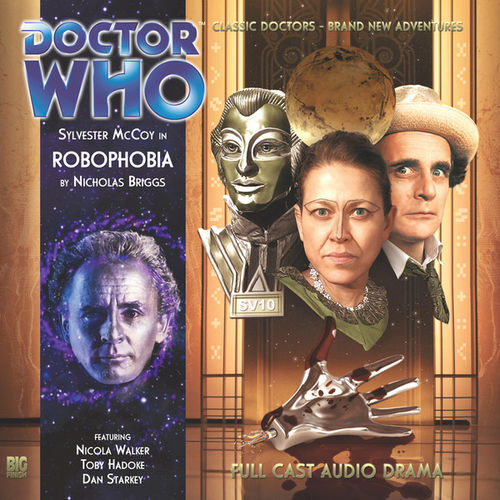Robophobia

|
|
Big Finish Productions Robophobia |

|
| Written by | Nicholas Briggs |  |
| Format | Compact Disc | |
| Released | 2011 |
| Starring Sylvester McCoy |
| Synopsis: Nothing has ever been officially confirmed, but there is a rumour that on a Sandminer bound for Kaldor City, the robots somehow turned homicidal and nearly wiped out the entire crew. Can that really be true? The robot transport ship Lorelei has a cargo of over a hundred fifty-seven thousand robots on board, all deactivated. So even if there were any truth in the rumour of that massacre, there'd still be no danger. Surely, there wouldn't... But then, the Doctor witnesses a murder. |
Death and The Robots by Niall Jones 22/1/22
The most obvious thing to say about Robophobia is that it is a sequel to The Robots of Death. The opening scene even includes a radio broadcast summarising the events of the Tom Baker serial, making it clear that the two stories are connected by plot and chronology, as well as by theme. The Doctor's observation that it is 'interesting how history gets distorted', however, makes it clear that there is something off about the connection.
Despite this, Robophobia begins like a remake of The Robots of Death. All the tropes that audiences would expect from its sequel are present: the enclosed setting, the impassive robots, the violent deaths. The opening scene even ends with a robot strangling the Doctor, echoing Robots of Death's best-known cliffhanger. The fact that this attack comes immediately after the Doctor witnesses the murder of Tal Kanus by a robot is significant, as it makes it seem clear that the robots are the enemy. When other characters are murdered later in the story, therefore, the audience makes the obvious leap that the robots are also responsible for those killings.
The effect of the opening scene is to create an impression that the audience knows what is going on, that the robots are murdering the crew as the first stage of a revolution against their human masters. The revelation of the truth in the second half, therefore, comes as something of a surprise.
Unlike The Robots of Death, Robophobia features the Seventh Doctor. Sylvester McCoy plays the Doctor as a mysterious figure, manipulating events from behind the scenes and issuing cryptic statements, such as 'things are not what they seem'. The audience gets the impression that the Doctor knows exactly what is going on from very early in the story and simply wants the other characters to work it out for themselves. This makes the Doctor a slightly unsettling presence. In fact, his actions in the first half of the story - planting a bomb, activating the robots - are initially inexplicable and, for once, make the ship's captain seem justified in locking him up.
Although the Doctor arrives aboard the Lorelei without a companion, so med-tec Liv Chenka takes on that role for the duration of the episode. Played by Nicola Walker, Liv has a no-nonsense approach to her work and is largely unconvinced by the Doctor. In fact, she is often quite suspicious of him. The fact that the story is set in her world also affects her relationship with the Doctor. Whereas the Doctor is detached from the events going on around him, Liv is directly affected by the deaths that occur on the Lorelei, rebuking the Doctor for making her double-check the injuries that caused the deaths of her friends. That this contrast reflects badly on the Doctor suggests that writer Nicholas Briggs (at least for this story) reimagines the companion role in a new light. Instead of bringing out the best in the Doctor and highlighting their brilliance and heroism, the mirror held up by the companion emphasises the Doctor's alienness and sometimes callous nature.
While the episode ends with the Doctor once again companionless, Liv does go on to join the Eighth Doctor in the TARDIS in Dark Eyes 2. From the evidence presented in Robophobia, it is clear why the writers wanted Liv to return. She is an excellent character whose sceptical attitude towards the Doctor contrasts nicely to the revived TV series, where it has become common for companions to have romantic feelings for the Doctor, while her outward toughness belies a deeply compassionate nature.
Overall, Robophobia achieves what it sets out to do admirably: to be a sequel to a much-loved classic of 1970s Doctor Who that nevertheless does something new and different by subverting its tropes. That the solution to the murders is surprising when revealed but obvious in hindsight is significant, as it shows just how well-plotted the story is.
It is also worth adding that Robophobia succeeds as an audio drama. It not only makes good use of sound, with the aggressive pulsing of the voices that awaken the Doctor from unconsciousness being a particularly striking example, but also ensures that sound is essential to the development of the plot. It is noteworthy, for example, that it is the impassive voices of the robots that the crew members find particularly disturbing, while music plays an important role in the unfolding of the plot in the second half of the story.
Ultimately, Robophobia is a cleverly constructed story that shows that sequels do not have to be exercises in nostalgia. By substituting the reassuring presence of the Fourth Doctor with the scheming Seventh Doctor, Robophobia creates something that, while aesthetically similar to The Robots of Death, is ultimately very different.